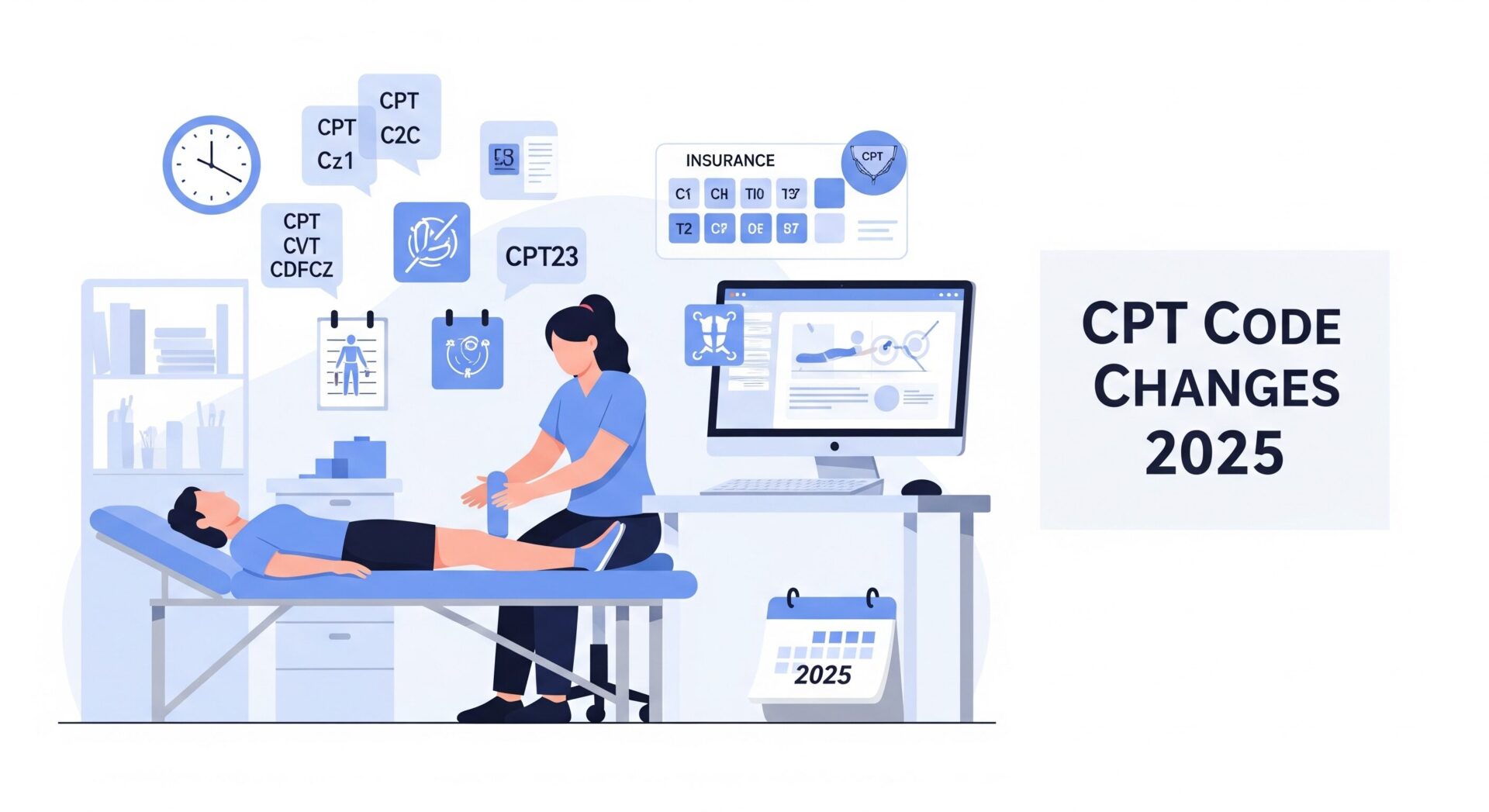It’s already halfway through 2025, and if you’ve noticed more claim denials or payment delays than usual, there’s a good chance it has something to do with this year’s CPT code updates.
The 2025 CPT changes, effective since January 1, introduced several revisions that directly impact how physical therapy clinics bill for common services, especially when it comes to digital care, remote monitoring, and documentation.
Some practices made adjustments early. Others are still catching up. Either way, it’s worth reviewing what’s changed in physical therapy CPT codes and how it could be affecting your bottom line today.
What Are the Key Changes for Physical Therapy CPT Codes in 2025?
1. RTM Codes Revised to Cover More Digital Interventions
Remote Therapeutic Monitoring (RTM) codes now reflect broader use of digital health tools.
- Code 98975 expands to include digital therapeutic intervention
- Codes 98976–98978 now emphasize device supply for data access and remote tracking
If your clinic uses apps, trackers, or platforms to monitor patient progress, these changes allow for more accurate billing—and help recover time you previously spent without compensation.
2. New Category III Codes Recognize AI-Assisted Services
Artificial Intelligence now holds space in the CPT codebook. New Category III codes describe medical services that involve AI-supported data analysis, especially in imaging and diagnostics.
While these codes don’t directly apply to PT services, they mark a shift in how AI tools—like movement tracking and digital rehab assessments—might be reimbursed in the near future.
3. General Surgery Code Revisions Affect Rehab Documentation
CPT updates related to wound care and tumor removal may indirectly affect post-op therapy billing. Clinics working with patients post-surgery must align their documentation with the revised surgical code language to ensure smooth authorization and claim approval.
How are These Changes Impacting Billing in 2025?
The biggest impact isn’t just the new codes. It’s the shift in what’s expected in your notes. Especially if you’re billing for remote services or digital tools.
Remote Services Now Require More Specific Documentation
Saying “monitored patient remotely” doesn’t count anymore. You need to include:
- What tech or app was used
- Whether the data was reviewed by a therapist
- How it influenced your treatment decisions
- How the patient responded
If that detail’s missing, payers are either denying the claim or kicking it back for more info.
Telehealth Still Brings Modifier Confusion
Some PT clinics still offer hybrid care. But payers haven’t fully agreed on how they want those services billed. Some require modifier 95. Others want GT. Some expect additional documentation about the interaction itself. It changes depending on the insurer.
Even one missing modifier can mean a payment delay of weeks.
Medicare’s Conversion Factor Dropped
The 2025 Medicare conversion factor went down again, which means your claims are getting paid out a little less per visit. That makes every clean claim more important than it was last year.
MPPR Still Applies
If you bill multiple timed services during the same session, the Multiple Procedure Payment Reduction policy still reduces the payment on the second, third, and so on. The cut is applied to the practice expense portion of the reimbursement.
If you’re not tracking time carefully or stacking codes without support, this can lower your payout.
What Are Clinics Doing to Stay Ahead?
Many PT practices made early adjustments to avoid denials and boost reimbursement:
Reviewing High-Volume Codes
Clinics started by auditing their most-used physical therapy CPT codes. Comparing documentation against new CPT definitions helped identify gaps early.
Updating Notes and Templates
Therapists adjusted evaluation and treatment notes to reflect new complexity levels, treatment goals, and digital service use.
Retraining the Whole Team
From front desk to clinical staff, teams aligned on new billing triggers—like when to use a KX modifier or how to document RTM properly.
Speaking Directly to Payers
Proactive communication with insurance reps helped clarify expectations and avoid weeks of unnecessary back-and-forth.
Is It Too Late to Catch Up on These Changes?
Not at all. Now is the perfect time to assess your billing performance and close gaps.
Use this mid-year checkpoint to:
- Audit a week’s worth of claims
- Review how RTM and telehealth codes show up in your software
- Ensure documentation supports timed services and treatment decisions
- Confirm KX modifier use for patients exceeding the therapy threshold (~$2,330 for PT + SLP)
Need Help Sorting It All Out?
At Rapid RCM Solutions, we work with physical therapy clinics to clean up documentation, correct CPT usage, and reduce preventable denials. We know how much effort goes into every visit, and we make sure the billing reflects that.
Whether you need help with RTM claims, Medicare billing, or just catching up on what changed in 2025, we’ll help you get back on track.
Let us handle the billing. You handle the healing.
FAQs
What should I do if a claim is denied due to CPT code changes?
Review the denial reason, fix documentation if needed, and contact the payer before submitting an appeal.
What mistakes should I avoid when billing with new CPT codes?
Watch out for outdated codes, missing modifiers, poor documentation, and confusion around RTM requirements.
Where can I find official info on CPT code updates for PT?
Check the AMA CPT codebook, CMS updates, your state PT board, or APTA for the latest guidance.





